Christies Auction
6 Sep, 2022
(edited)
2022-9-6 3:43:23 PM UTC
2022-9-6 3:43:23 PM UTC
Thanks to onthetrail for this
Christies Auction New York
6 October 12:00 PM EDT | Live auction 19289
Valuable and Important Books and Manuscripts from the Library of Edward R. Leahy
Lot 144 - Proofs for the Lord of the Rings trilogy

Estimate USD 20,000 - USD 30,000
Sold for USD 60,480 inc. fees
https://www.christies.com/lot/lot-6389714
Lot 145 - The Lord of the Rings trilogy(sic)

Estimate USD 12,000 – USD 18,000
Sold for USD 21,420 inc. fees
https://www.christies.com/lot/lot-6389715
Lot 146 - The Lord of the Rings trilogy(sic), in an Asprey binding

Estimate USD 25,000 – USD 35,000
Sold for USD 25,200 inc. fees
https://www.christies.com/lot/lot-6389716
Lot 147 - On the runes used in The Hobbit

Estimate USD 30,000 – USD 50,000
Sold for USD 107,100 inc. fees
https://www.christies.com/lot/lot-6389717
Video of this lot Rune Letter
Letter from J.R.R. Tolkien to Leila Keene and Pat Kirke • 3 August 1943 (#119)
Lot 148 - On his progress writing Lord of the Rings
Estimate USD 12,000 - USD 18,000
Sold for USD 27,720 inc. fees
https://www.christies.com/lot/lot-6389718
Letter from J.R.R. Tolkien to Leila Keane and Patricia Kirke • 9 January 1945 (#572)
Lot 149 - On the death of C.S. Lewis and Lord of the Rings
Estimate USD 8,000 – USD 12,000
Sold for USD 21,420 inc. fees
https://www.christies.com/lot/lot-6389719
Letter from J.R.R. Tolkien to Przemyslaw Mroczkowski • 20-26 January 1964 (#543)
Lot 150 - The Lord of the Rings trilogy, a family copy

Estimate USD 15,000 – USD 25,000
Sold for USD 27,720 inc. fees
https://www.christies.com/lot/lot-6389720
Christies Auction New York
6 October 12:00 PM EDT | Live auction 19289
Valuable and Important Books and Manuscripts from the Library of Edward R. Leahy
Lot 144 - Proofs for the Lord of the Rings trilogy

J.R.R. Tolkien, 1954
TOLKIEN, John Ronald Reuel (1892-1973). Lord of the Rings Trilogy – The Fellowship of the Ring. London: Allen & Unwin, 1954. [With:] – The Two Towers. London: Allen & Unwin, 1954. [And:] – The Return of the King. London: Allen & Unwin, 1954.
Rare advance proofs for the first editions of the Lord of the Rings trilogy, a very fresh set. Loosely inserted to volume 1 is a slip bearing the compliments of the publisher, signed “L.G. Berry.” Hammond notes for Fellowship of the Ring that "the publisher's cost book records 20 copies bound in wrappers (not seen), presumably for review and samples" (A5a.i.). No copies in wrappers are recorded for the other two volumes. Interestingly the price on the cover label for is recorded as "about 21s". All three first editions were eventually published with a price of 21 shillings.
Three volumes, octavo (222 x 140mm). Half titles, vol. 1 with folding map at rear printed in black and red (vol. 2 with 90 mm closed tear to one page affecting upper corner of text, vol. 3 with some foxing to prelims, faint bump to upper corners of last two vols). Plain brown wrappers, vol. 2 only with typed labels with title, author, and price to upper cover (a little minor soiling and creasing, vol. 1 with minor repair to paper at upper spine). Custom chemises and quarter morocco slipcase.
Estimate USD 20,000 - USD 30,000
Sold for USD 60,480 inc. fees
https://www.christies.com/lot/lot-6389714
Lot 145 - The Lord of the Rings trilogy(sic)

The Lord of the Rings trilogy
J.R.R. Tolkien, 1954-55
TOLKIEN, John Ronald Reuel (1892-1973). Lord of the Rings Trilogy – The Fellowship of the Ring. London: Allen & Unwin, 1954. [With:] – The Two Towers. London: Allen & Unwin, 1954. [And:] – The Return of the King. London: Allen & Unwin, 1955.
One Ring to rule them all, One Ring to find them,
One Ring to bring them all and in the darkness bind them
The first edition, first impression, of the greatest fantasy trilogy of the modern era. C.S. Lewis wrote of it that: “no imaginary world has been projected which is at once as multifarious and so true to its own inner laws; none so seemingly objective, so disinfected from the taint of an author’s merely individual psychology; none so relevant to the actual human situation yet so free from allegory.” Tolkien, a noted scholar of Old English, conceived the idea for his tales set in “Middle Earth” while in the trenches of the First World War; its immense influence has been felt ever since.
The present is a lovely set comprising the first edition, first impression of the first two books and the first edition, first impression, second state of The Return of the King. Hammond’s bibliography originally noted that the first impression, first state, was marked by the signature mark “4” and sagging type on page 49, but has since corrected this to say that these are indicative of the first impression, second state. Hammond and Anderson A5.a.i-iii.
Estimate USD 12,000 – USD 18,000
Sold for USD 21,420 inc. fees
https://www.christies.com/lot/lot-6389715
Lot 146 - The Lord of the Rings trilogy(sic), in an Asprey binding

The Lord of the Rings trilogy, in an Asprey binding
J.R.R. Tolkien, 1954-55
TOLKIEN, John Ronald Reuel (1892-1973). Lord of the Rings Trilogy – The Fellowship of the Ring. London: Allen & Unwin, 1954. [With:] – The Two Towers. London: Allen & Unwin, 1954. [And:] – The Return of the King. London: Allen & Unwin, 1955.
First editions finely bound in full pictorial morocco gilt extra by Asprey featuring Gandalf, Smaug, Aragorn, Frodo, Samwise Gamgee, and Gollum on the covers; together with the original drawings for the design. Pristine condition. Framed beneath gilt archways, each front cover depicts a different character in multiple colors of onlaid morocco. On Fellowship of the Ring, Gandalf holds his staff with his right hand and points into the distance with his left, a full moon and clouds above. Two Towers features as Smaug writhing in the air above the River Running, the Lonely Mountain behind. Smaug's scales are stamped in silver and his wings are blue painted translucent vellum. Aragorn is on the front cover of Return of the King, wearing the Winged Crown and with his sword raised above his head. The lowers covers and the spines are all uniform and each with gilt-stamped archways. The lower covers depict Frodo Baggins, Samwise Gamgee and Gollum trying to find their way; the spines show an elven king in full length.
The present set is comprised of the first edition, first impression of the first two books and the first edition, first impression, second state of The Return of the King. Hammond’s Tolkien bibliography originally noted that the first impression, first state, was marked by the signature mark “4” and sagging type on page 49, but has since corrected this to say that these are indicative of the first impression, second state. Hammond and Anderson A5.a.i-iii.
Three volumes, octavo (212 x 131mm). Half titles, each volume with map printed in red and black tipped in at rear. Full pictorial morocco gilt bindings by Asprey, each cover with colored morocco onlays , all edges gilt, turn-ins gilt, watered silk doublures; original dust jackets bound in at end. Half morocco clamshell box with velvet dividers stamped in gilt. [Together with:] Six original drawings for the binding by Asprey, most measuring about 295 x 209mm, housed together in a custom clamshell box.
Estimate USD 25,000 – USD 35,000
Sold for USD 25,200 inc. fees
https://www.christies.com/lot/lot-6389716
Lot 147 - On the runes used in The Hobbit

On the runes used in The Hobbit
J.R.R. Tolkien, 3 August 1943
TOLKIEN, John Ronald Reuel (1892-1973). Autograph letter signed (“JRR Tolkien” and again in Anglo Saxon) to Miss Leila Keane and Miss Pat Kirke, Oxford, 3 August 1943.
Eight pages, 227 x 177mm, with additional 60 x 178mm slip pinned to page four, on Tolkien’s Northmoor Road stationery (light wear at creases) with original transmittal envelope addressed in his hand (marginal tears with minor losses).
The Rosetta Stone of Middle Earth—a remarkable letter explaining the development of the runes and languages used in The Hobbit. Writing to Leila Keane and Pat Kirke, two young fans of The Hobbit, Tolkien, across eight pages, discusses runes at length, explaining what they are, and including alphabets and phrases compiled from them. The letter begins: “It’s some while since I heard from you, but I have been rather busy, and have had to put off answering your letter, until I could deal with your questions about Runes – not properly, because that would take a book or two; but at least decently. There are two different matters here: one is Runes in what is called ‘historical times’ (only about a thousand years ago); and Runes and strange writings in the much older times which ‘The Hobbit’ talks about. I don’t know which you want to know about – perhaps about both” Assuming the answer was yes, Tolkien opens with a "a few notes on 'historical' Runes." He explains that wide variety of runes "were chiefly used by the Norsemen, and by the English (in the old days before, say, A.D. 1000)." Some dated as early as the year 400 C.E. and while most fell out of use, they were still occasionally used in Iceland. Yet, "The English Runes were the best," and were used extensively in "Old English (or 'Anglo-Saxon')" and at the time possessed the potential to "become a 'book alphabet' for writing, but it never did." Anglo-Saxon writers adopted Latin characters in the seventh century, yet they incorporated a few runic characters at the time, but those too eventually fell out of use. He then proceeds to map out the "oldest simple runic alphabet of 24 letters," explaining how each runic character was the first letter of its name, "which was a real word … as if we called our alphabet archer bull cow down elm fire, etc." Over the next two pages, he draws each rune, lists the Anglo-Saxon word, the modern translation and then the sound equivalent in Latin characters. He then offers a "bit of 'Anglo-Saxon' in ordinary writing (of the time)," and a transliteration in Latin characters.
Realizing that he may "have written too much on 'historical' runes," he moves on to "the days of Bilbo." He admits that The Hobbit had to be "modernized and turned into English," but asks if they had the original dustjacket for the book and calls their attention to the runic inscription around the edges. "Have you deciphered it If you have you will see that 'The Hobbit' was compiled from Bilbo Baggins' memoirs (how they survived is another matter). But you can see my difficulty: — none of the various peoples in those days, of course, spoke English, but all the accounts had to be made readable, by people, too, who might not be very much interested in languages and old alphabets." He concedes that the effort was not "too difficult" noting that there was a commonly spoken language, "a sort of Lingua-franca," composed of a variety of dialects, "called the Western Language or the common Speech." He describes the historical spread of the language and how English served as the stand-in for "common speech." He goes into depth on the languages of the dwarves ("…they kept if very secret, not wanting others to learn it…") and describes how they would use the common language to communicate with others, observing that they were adept at learning languages not their own. He also touches on "Elvish languages," and while suspecting that his correspondents, "have had enough now," dashes off "a specific of Elf-hand." that consumes the final page headed "Runes used by Thorin & Co." (Filling eight pages completely, he had little choice to add his signatures in the left margin of page seven.)
An amazing letter explaining the philology of Middle Earth and shedding additional light on Tolkien’s personality and character. Although consumed with academic duties and his monumental writing project, Tolkien still managed to devote considerable time and energy to respond to the enquires of his devoted young fans. Provenance: Sotheby’s, 4 May 1995, lot 252.
Estimate USD 30,000 – USD 50,000
Sold for USD 107,100 inc. fees
https://www.christies.com/lot/lot-6389717
Video of this lot Rune Letter
Letter from J.R.R. Tolkien to Leila Keene and Pat Kirke • 3 August 1943 (#119)
Lot 148 - On his progress writing Lord of the Rings
On his progress writing Lord of the Rings
J.R.R. Tolkien, 1945
TOLKIEN, John Ronald Reuel (1892-1973). Autograph letter signed ("Ye olde Professor JRRT") to Leila Keane and Patricia Kirke, Oxford, 9 January 1945.
Three pages, 85 x 122mm on his blind embossed stationery.
A lengthy letter detailing Tolkien's progress with Lord of the Rings. The recipients, Leila Keane and Patricia Kirke, were two young girls who maintained a lengthy correspondence and friendship with Tolkien after reading The Hobbit. Tolkien apologizes for not writing for nearly a year citing his busy work and writing schedule. "That next book is not finished yet, and it almost looks as if you'll be grown up before it is. But I hope you won't quite change your tastes!" He takes time to answer questions from their previous notes: "I illustrated 'The Hobbit' myself (very poorly, I think), but I shan't have time even to try and illustrate this one! I began it about 1938, and it is still growing slowly. Not only the Hobbit (Mr. Baggins), but quite a host of hobbits of the Baggins and other families come into it, as well as a great many creatures and people not before seen …. It starts with a 'A Long-expected party' (on Bilbo's 111th birthday), and follows the adventures of Frodo, Bilbo's nephew, and Sam his servant in much longer and more perilous journeys to Rivendell and then far away South to the Mines of Mora, and Rohan and Gandor, and at last to the dreadful land of the Dark Lord ... But except to say that’s all about Bilbo's Magic Ring (which I may have told you before) I won't tell the plot." Tolkien explains that there are "five books or parts," and that he had begun work on the fifth with his son "Christopher, who has helped me a lot, and was just drawing some lovely maps, of The Shire (where the Hobbits live) and of the Great Lands, was taken away and has been in Africa nearly a year…." He also reports on his son Michael was "invalided out of the army", his eldest, John was "now a 'Rev.' So all the original hobbiters are growing up." His daughter Racheal, "only 15," refused to read the novel until completion, "though she has typed out some of the chapters." He continues with additional family news noting that his son Chris was living in "the Orange River Free State," Tolkien's birthplace, but his son didn't "like it at all. Especially not a Christmas in midsummer, and the moon upside down." Tolkien's full-time academic role slowed progress greatly on Lord of the Rings. He did not complete the manuscript until 1949 and the book took another five years to appear in print (1954-1955). Not published in Carpenter.
Estimate USD 12,000 - USD 18,000
Sold for USD 27,720 inc. fees
https://www.christies.com/lot/lot-6389718
Letter from J.R.R. Tolkien to Leila Keane and Patricia Kirke • 9 January 1945 (#572)
Lot 149 - On the death of C.S. Lewis and Lord of the Rings
On the death of C.S. Lewis and Lord of the Rings
J.R.R. Tolkien, 1964
TOLKIEN, John Ronald Reuel (1892-1973). Autograph letter signed (“Ronald Tolkien”) to [Przemyslaw] Mroczkowski, Oxford, 20-26 January 1964.
Four pages, 228 x 178mm on his blind-embossed stationery (light foxing at corners, and minor separation at fold to second leaf).
"A dreadful year of loss and frustration" — On the deaths of C.S. Lewis (and JFK) and lengthy discussion of The Lord of the Rings. Tolkien responds to a sympathetic letter from his correspondent to pour out a tale of the "dreadful" year of 1963: "The low reached for me its climax on Nov. 22nd, not for me the day Kennedy was murdered, but the day C.S. Lewis died." Then, Tolkien and his wife were so ill as not to be able to celebrate Christmas: "I did not even manage to put up even a sprig of holly this year"; the next disaster was in their son Christopher's divorce: "A shadow, only guessed by us, has been falling on my son Christopher and his wife … soon after Christmas disaster came on them and us. His wife walked out ... I fear they have left their allegiance to our Mother [the Church]." The letter continues with a detailed discussion of The Lord of the Rings, considering Mroczkowski's suggestion as to "the simultaneity of different planes of reality touching one another ... part of the deeply felt idea that I had ... Beyond that too I feel that no construction of the human mind, whether in imagination or the highest philosophy, can contain within its own 'englobement' all that there is ... There is always something left over that demands a different or longer construction to 'explain' it ... This is like a 'play,' in which ... there are noises that do not belong, chinks in the scenery," discussing in particular the status of Tom Bombadil in this respect. He offers his admiration to Mroczkowski's ability, in spite of his illness, "to plod through a voluminous 'Preface to Chaucer'! I know that my sloth is the chief reason for my reluctance to reach such books, but apart from that I do become more and more skeptical of their value. … Alas! I remain a very unlearned man—which does not matter much now, but which made me feel something of a fraud when I occupied a 'chair' (by accident rather than merit)." Tolkien concludes with apologies if he seems too earnest and makes references to his wife's ill health. J.R.R. Tolkien and C.S. Lewis became fast friends after they first Oxford in 1926—bonding over their shared experiences serving in the First World War as well as their shared passion for stories, poetry, and language. Tolkien would remark that Lewis was for many years “my only audience,” and he owed the creator of Narnia “an unpayable debt,” not for “influence but sheer encouragement.” (Tolkien to Plotz, 12 September 1965, published in Letters, 362). Tolkien and Mroczkowski had begun corresponding in 1946 but did not meet in person before the Polish-born professor arrived in Oxford in 1957, where he spent a year doing post-doctoral research. Their shared passion for medieval literature and culture nurtured a friendship and continued correspondence following Mroczkowski’s return to Poland the following year. For a fuller discussion of their friendship and correspondence, see Lukasz Neubauer, “The ‘Polish Inkling’: Professor Przemyslaw Mroczkowski as J.R.R. Tolkein’s Friend and Scholar,” Mytholore 39:1 (Fall, 2020), pp. 149-176. Provenance: Christie’s, 1 June 2009, lot 76.
Estimate USD 8,000 – USD 12,000
Sold for USD 21,420 inc. fees
https://www.christies.com/lot/lot-6389719
Letter from J.R.R. Tolkien to Przemyslaw Mroczkowski • 20-26 January 1964 (#543)
Lot 150 - The Lord of the Rings trilogy, a family copy

The Lord of the Rings trilogy, a family copy
J.R.R. Tolkien, 1966
TOLKIEN, John Ronald Reuel (1892-1973). Lord of the Rings Trilogy – The Fellowship of the Ring. London: Allen & Unwin, 1966. [With:] – The Two Towers. London: Allen & Unwin, 1966. [And:] – The Return of the King. London: Allen & Unwin, 1966.
Each volume signed by J.R.R. Tolkien on the half title, with his grandson's ownership inscription on the front endpaper: “Michael G.R. Tolkien / Uppingham / (Signed by Grandfather).” Poet and critic Michael George Reuel Tolkien (b. 11 January 1943) is the son of Michael H.R. Tolkien. A fine set of the second edition of this celebrated trilogy, from the Tolkien family.
Three volumes, octavo. Half titles, each volume with map printed in red and black (vol. 1 map loosely inserted). Original red cloth; printed dust jackets (slightest rubbing). Custom half morocco clamshell box.
Estimate USD 15,000 – USD 25,000
Sold for USD 27,720 inc. fees
https://www.christies.com/lot/lot-6389720
















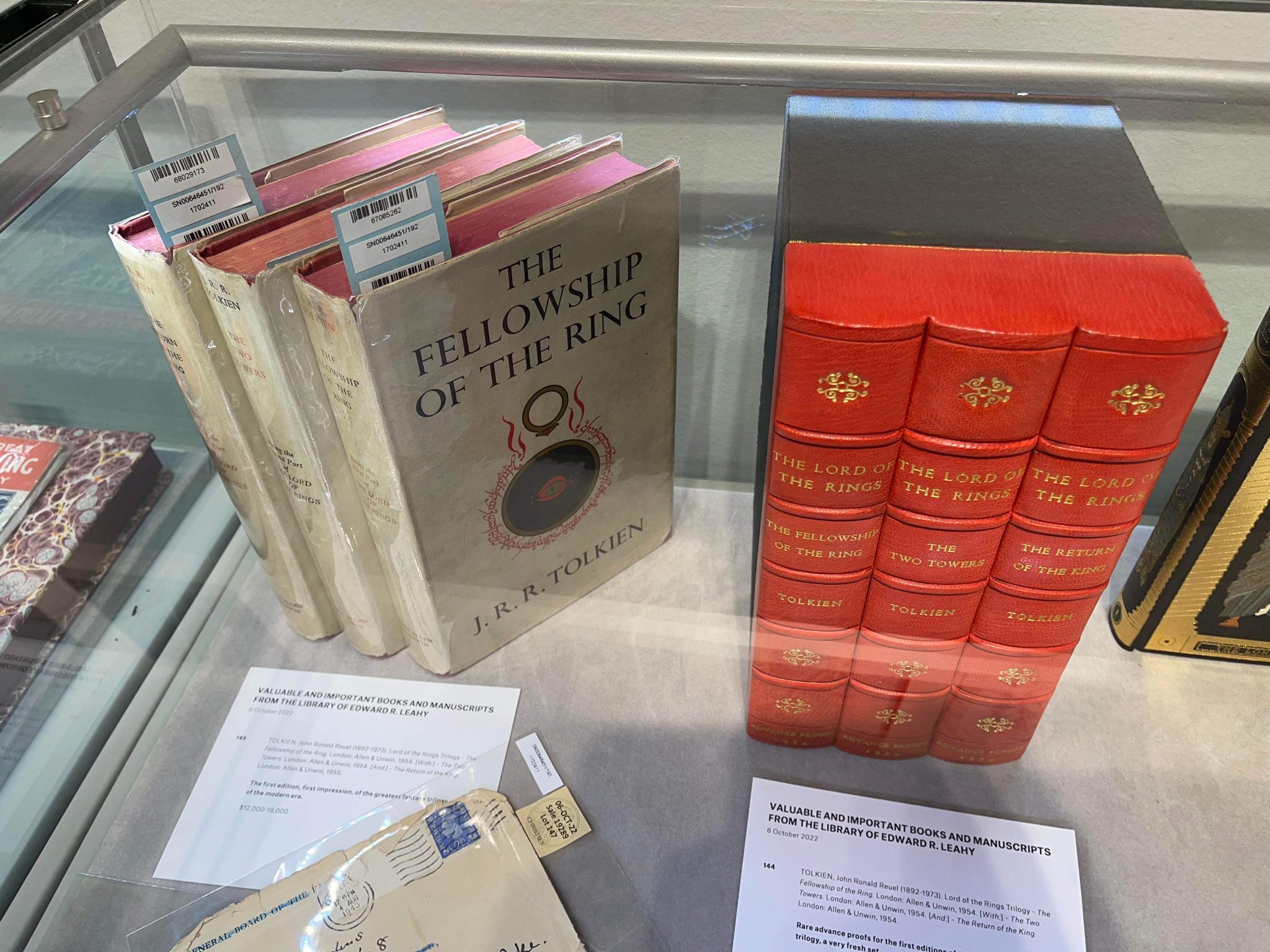
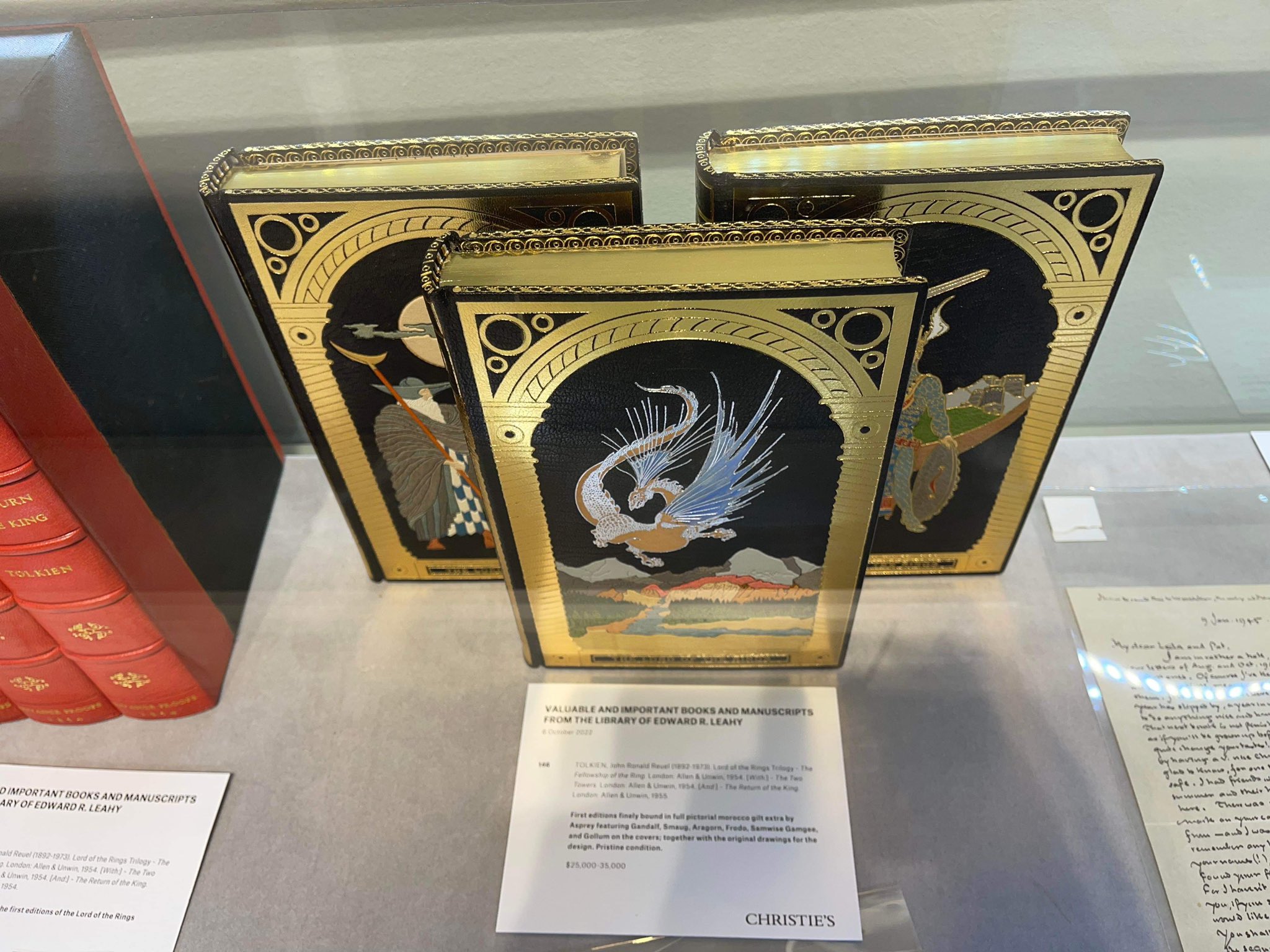
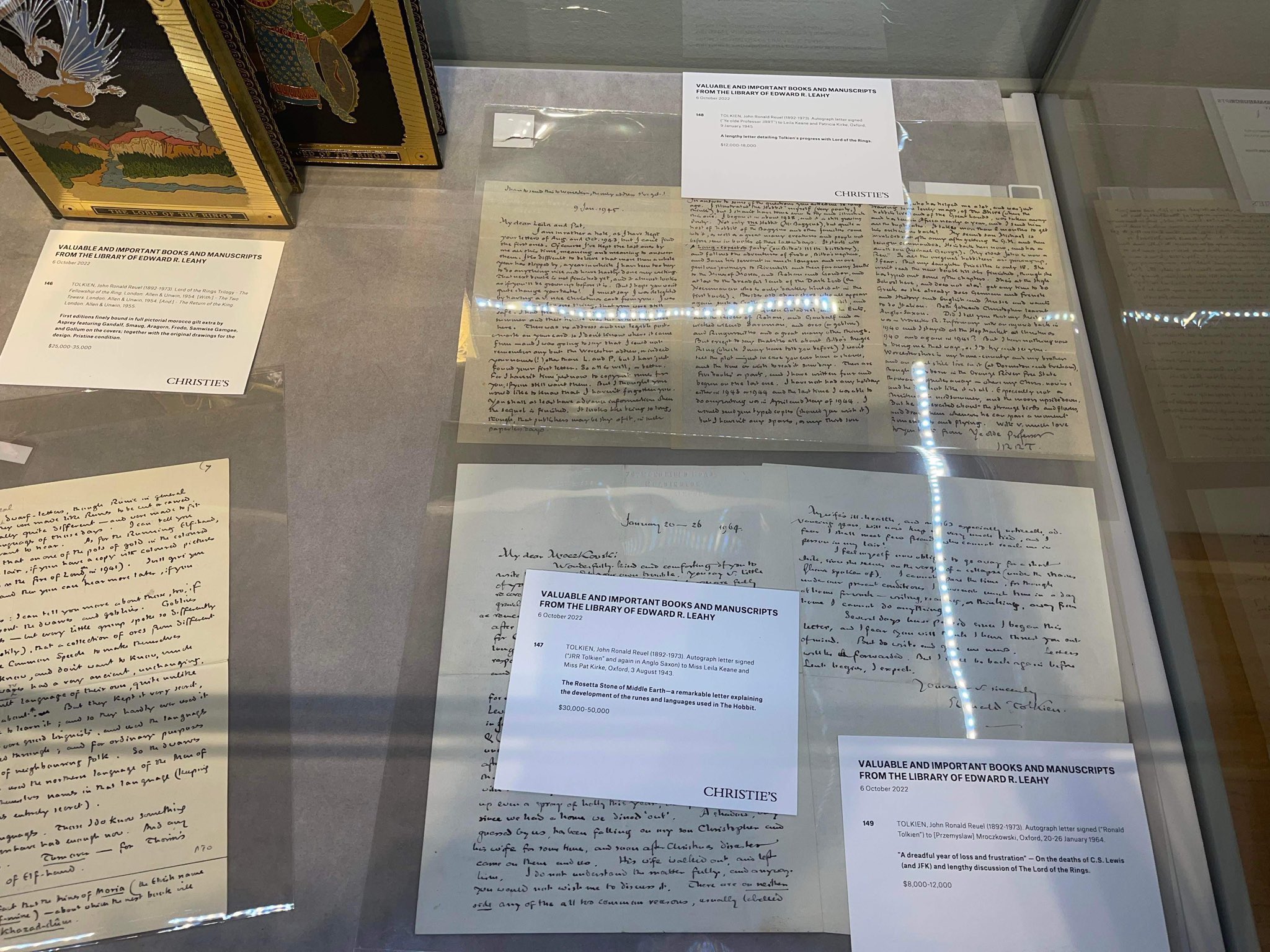
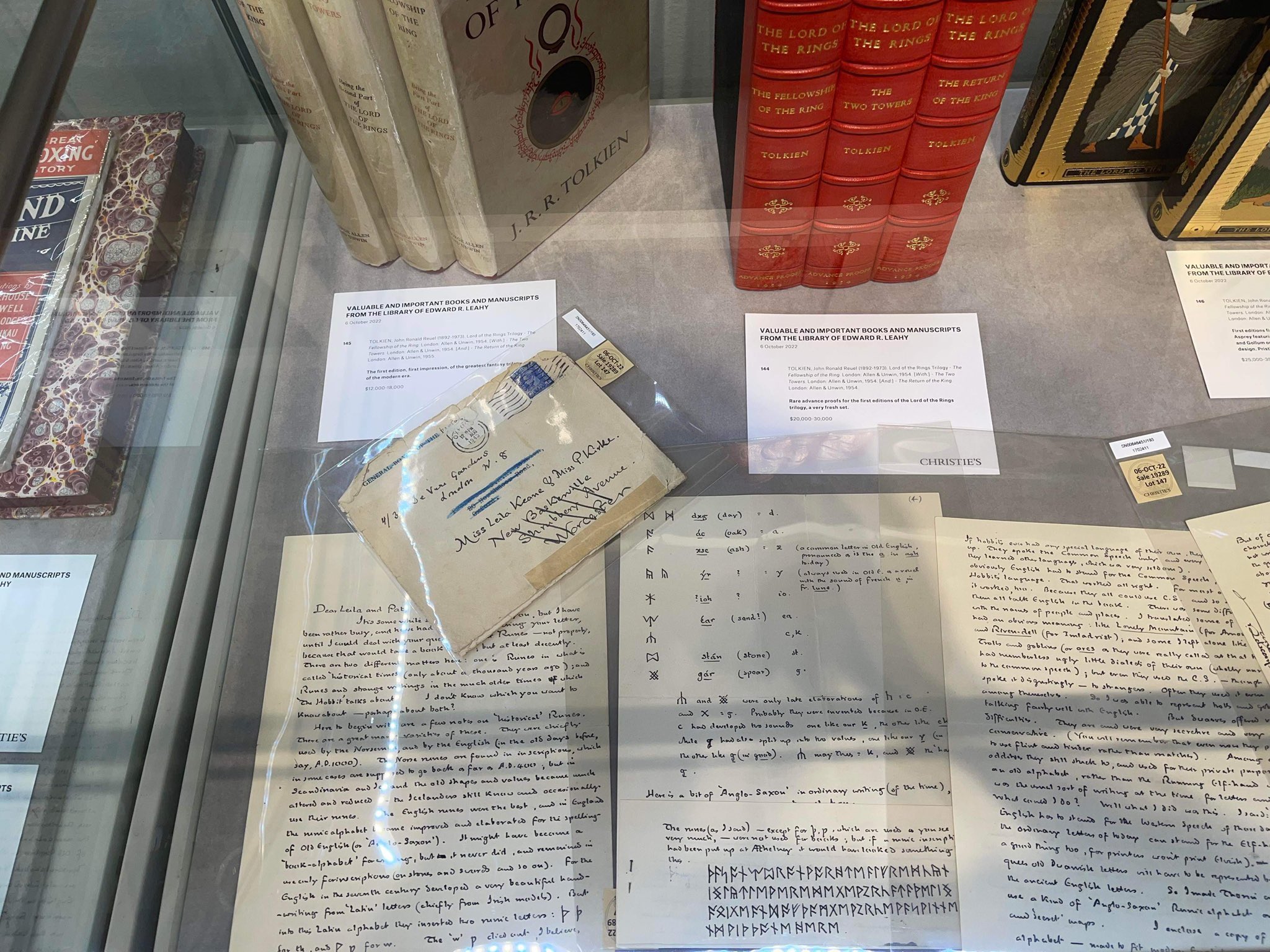
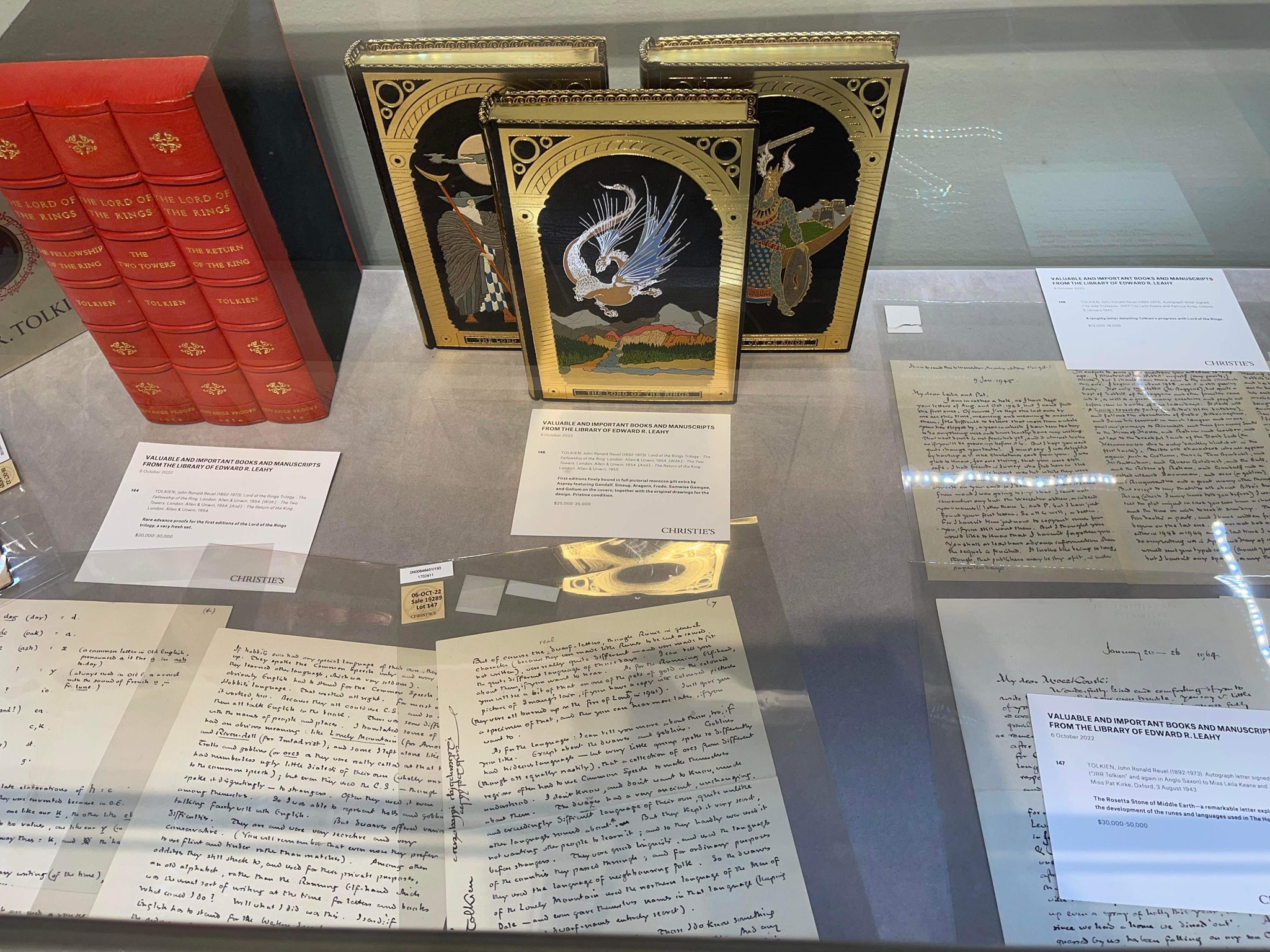

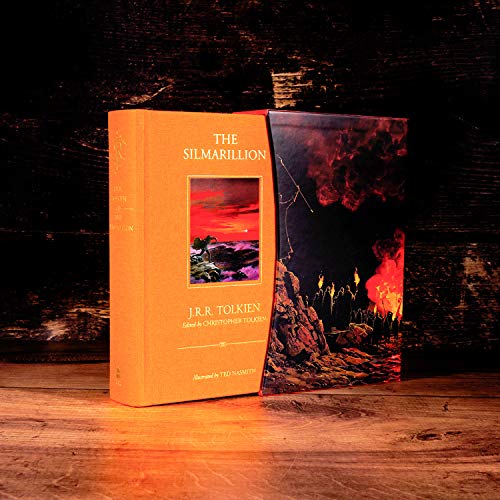
 107
107 16491
16491